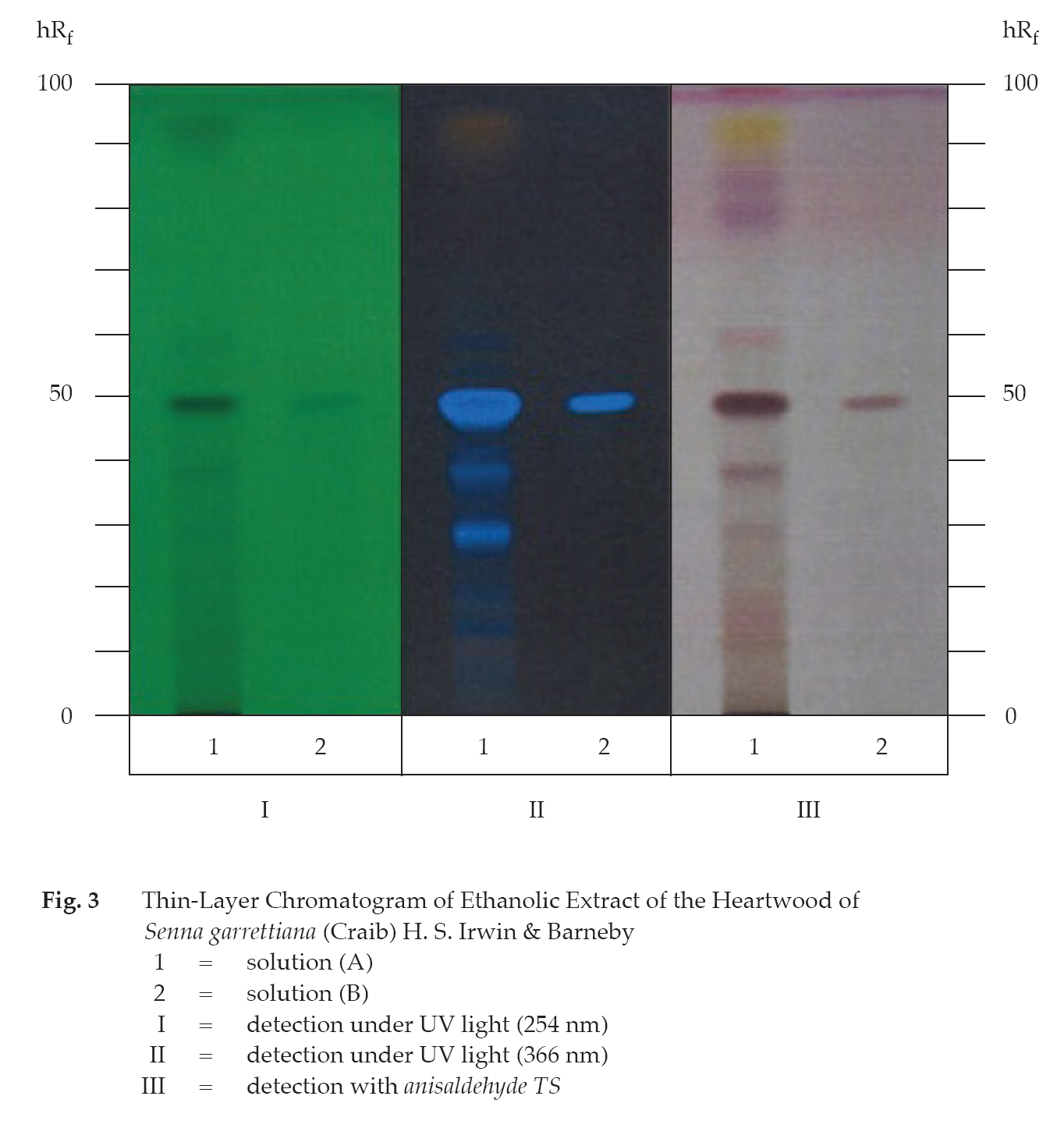ตำรามาตรฐานยาสมุนไพรไทย
Thai Herbal Pharmacopoeia
สำนักยาและวัตถุเสพติด กรมวิทยาศาสตร์การแพทย์ กระทรวงสาธารณสุข
Bureau of Drug and Narcotic, Department of Medical Sciences, Ministry of Public Health(Tinospora crispa (L.) Hook.f. & Thomson)
(Nelumbo nucifera Gaertn.)
(Centella asiatica (L.) Urb.)
(Centella Dry Extract)
(Centella Cream)
(Mesua ferrea L.)
(Piper sarmentosum Roxb.)
(Piper sarmentosum Roxb.)
(Pterocarpus santalinus L. f.)
(Santalum album L.)
(Senna tora (L.) Roxb.)
(Senna alata (L.) Roxb.)
(Senna Alata Tea)
(Piper retrofractum Vahl)
(Myristica fragrans Houtt)
(Andrographis paniculata (Burm. f.) Nees)
(Andrographis Capsules)
(Allium ascalonicum L.)
(Ocimum tenuiflorum L.)
(Curcuma longa L.)
(Turmeric Capsules)
(Turmeric Dry Extract)
(Turmeric Dry Extract Capsules)
(Arcangelisia flava (L.) Merr.)
(Curcuma sp.)
Harrisonia perforata (Blanco) Merr.
(Aristolochia pierrei Lecomte)
(Zingiber officinale Roscoe)
(Ginger Capsules)
(Ginger Tea)
(Cassia fistula L.)
(Nardostachys jatamansi (D. Don) DC.)
(Angelica sinensis (Oliv.) Diels)
Artemisia annua L.
(Ligusticum sinense Oliv. cv. Chuanxiong)
(Neopicrorhiza scrophulariiflora Pennell)
(Atractylodes lancea (Thunb.) DC.)
(Aucklandia lappa Decne)
(Terminalia chebula Retz.)
(Angelica dahurica (Hoffm.) Benth. & Hook. f. ex Franch. & Sav. var. dahurica)
(Kaempferia parviflora Wall. ex Baker)
(Hibiscus sabdariffa L.)
(Roselle Tea)
(Allium sativum L.)
(Zingiber zerumbet (L.) Sm.)
(Wurfbainia testacea (Ridl.) Škorničk.& A. D. Poulsen)
(Cannabis sativa L.)
(Myristica fragrans Houtt)
(Dracaena cochinchinensis (Lour.) S. C. Chen)
(Ficus racemosa L.)
(Hyptis suaveolens (L.) Poit.)
Clerodendrum indicum (L.) Kuntze
(Phyllanthus emblica L.)
(Citrus hystrix DC.)
(Citrus hystrix DC.)
(Areca catechu L.)
(Momordica charantia L.)
Moringa oleifera Lam.
(Aegle marmelos (L.) Corrêa)
(Solanum trilobatum L.)
(Morus alba L.)
Gynostemma pentaphyllum(Thunb.)
Makino
(Clinacanthus nutans (Burm. f.) Lindau)
(Cissus quadrangularis L.)
(Mimusops elengi L.)
(Zingiber montanum (J. König) Link. ex A. Dietr.)
(Piper betle L.)
(Capsicum annuum L.)
(Capsicum Oleoresin)
(Capsicum Gel)
(Piper nigrum L.)
(Piper nigrum L.)
(Eurycoma longifolia Jack)
(Thunbergia laurifolia Lindl.)
(Piper wallichii (Miq.) Hand.-Mazz.)
Senna garrettiana (Craib) H. S. Irwin & Barneby
(Terminalia bellirica (Gaertn.) Roxb.)
(Terminalia chebula Retz.)
(Caesalpinia bonduc (L.) H. Roxb.)
(Tarlmounia elliptica (DC.) H. Rob., S. C. Keeley, Skvaria & R. Chan)
(Hog Creeper Vine Dry Extract Capsiles)
(Hog Creeper Vine Dry Extract)
(Brachypterum scandens (Roxb.) Miq.)
(Lepidium sativum L.)
(Nigella sativa L.)
(Cuminum cyminum L.)
(Foeniculum vulgare Mill.)
(Plantago ovata Forssk.)
(Pimpinella anisum L.)
(Carum carvi L.)
(Anethum graveolens L.)
(Trachyspermum ammi (L.) Sprague)
Albizia procera (Roxb.) Benth.
(Acorus calamus L.)
(Tiliacora triandra (Colebr.) Diels)
Cyanthillium cinereum (L.) H. Rob.
(Orthosiphon aristatus (Blume) Miq.)
Murdannia loriformis (Hassk.) R. S. Rao & Kammathy
(Capparis micracantha DC.)
(Chrysopogon zizanioides (L.) Roberty)
(Cyperus rotundus L.)
(Cannabis sativa L.)
(Syzygium aromaticum (L.) Merr. & L. M. Perry)
(Boesenbergia rotunda (L.) Mansf.)
(Acanthus ebracteatus Vahl)
(Acanthus ilicifolius L.)
(Kaempferia galanga L.)
(Curcuma comosa Roxb.)
Betula alnoides Buch.-Ham. ex D. Don
Cannabis sativa L.
Carthamus tinctorius L
Mitragyna speciosa (Korth.) Havil
Mallotus repandus (Rottler) Müll. Arg
Azadirachta indica A. Juss. var. siamensis Valeton
Azadirachta indica A. Juss. var. siamensis Valeton
Punica granatum L.
Rhinacanthus nasutus (L.) Kurz
Baliospermum solanifolium (Burm.) Suresh
Curcuma aeruginosa Roxb
Boesenbergia kingii Mood & L. M. Prince
Senegalia rugata (Lam.) Britton & Rose
Acacia concinna (Willd.) DC.
Senegalia rugata (Lam.) Britton & Rose
Acacia concinna (Willd.) DC.
Senna alexandriana Mill. var. alexandriana
Cassia acutifolia Delile, Cassia angustifolia Vahl
Butea superba Roxb. ex Willd.
[Plaso superba (Roxb. ex Willd.) Kuntze, Rudolphia superba (Roxb. ex Willd.) Poir.
Pueraria candollei Graham
ex Benth. var. mirifica (Airy Shaw & Suvat.) Niyomdham
Streblus asper Lour.
Suregada multiflora (A. Juss.) Baill. (Gelonium
multiflorum A. Juss.
Senna Garrettiana Heartwood is the dried heartwood of Senna garrettiana (Craib) H. S. Irwin & Barneby (Cassia garrettiana Craib) (Family Leguminosae-Caesalpinioideae), Herbarium Specimen Number: DMSC 5225, Crude Drug Number: DMSc 1098.
Constituents Senna Garrettiana Heartwood contains anthraquinones (e.g., aloe-emodin, cassialoin, chrysophanol, emodin) and stilbenes (e.g., cassigarols, piceatannol).
Description of the plant (Fig. 1) Tree up to 10 m tall; bark greyish black, cracked. Leaves even-pinnate, alternate; rachis 10 to 20 cm long; petiole 4 to 5 cm long; stipule early caducous; leaflets 6 to 9 pairs, lanceolate to broadly ovate, 5 to 9 cm long, 2 to 5 cm wide, apex acuminate, base rounded, margin entire, glabrous to pubescent; petiolule 4 to 6 mm long. Inflorescence compound raceme, terminal, 9 to 20 cm long; bract ovate, about 4 mm long, apex acute, caducous; bracteole minute. Flower bright yellow; pedicel 2.5 to 4 cm long; sepals 5, unequal, 2 outer smaller, about 5 mm long, 3 inner twice as long, broadly elliptic, puberulous outside; petals 5, obovate or obovate-elliptic, 1 to 1.8 cm long, 0.8 to 1.2 cm wide, with claw, about 4 mm long; stamens 10, 2 longest with flattened filaments, 7 to 8 mm long, anther 7 to 9 mm long, curved, opening by apical pores, 5 shorter with smaller anthers, and 3 stamens reduced, about 3 mm long; ovary superior, glabrous or puberulous, style short, stigma indistinct. Fruit pod, flattened, 15 to 22 cm long, 2 to 4 cm wide, often slightly twisted, glabrous or puberulous; stalk 3 to 5 cm long. Seed ovoid or oblong-ovoid, 6 to 9 mm long, about 5 mm wide, brownish.
Description Odour, mild; taste, bland.
Macroscopical (Fig. 1) Longitudinally sliced heartwood, rough, dense, hard, reddish brown to dark-brown.
Microscopical (Figs. 2a, 2b, 2c, 2d) Transverse section of the heartwood shows a diffused-porous wood type consisting of vessels, axial parenchyma, xylem rays, and fibres. Vessel, large, solitary or in cluster of 2 to 4, scattered, some containing brown substance. Axial parenchyma, paratracheal type, slightly thick-walled cells, some containing brown substance. Xylem ray, 1 to 2 layers, rectangular cells, some containing brown substance. Fibre, thick-walled cells, some containing brown substance. Radial and tangential longitudinal sections of the heartwood show vessels, axial parenchyma, xylem ray, and fibres. Vessel, large cylindrical, bordered-pitted, some containing brown substance. Axial parenchyma, rectangular, slightly thick-walled cells, some containing brown substance. Xylem ray: homocellular type, rectangular, porous, slightly thick-walled cells, some containing brown substance or prismatic crystals, in radial longitudinal view; uniseriate rays and mostly biseriate rays, in tangential longitudinal view. Fibre, thick-walled cells, some containing brown substance. Senna Garrettiana Heartwood in powder possesses the diagnostic microscopical characters of the unground drug. Groups of fibres, some containing brown substance are unique. Large bordered-pitted vessels may also be observed.
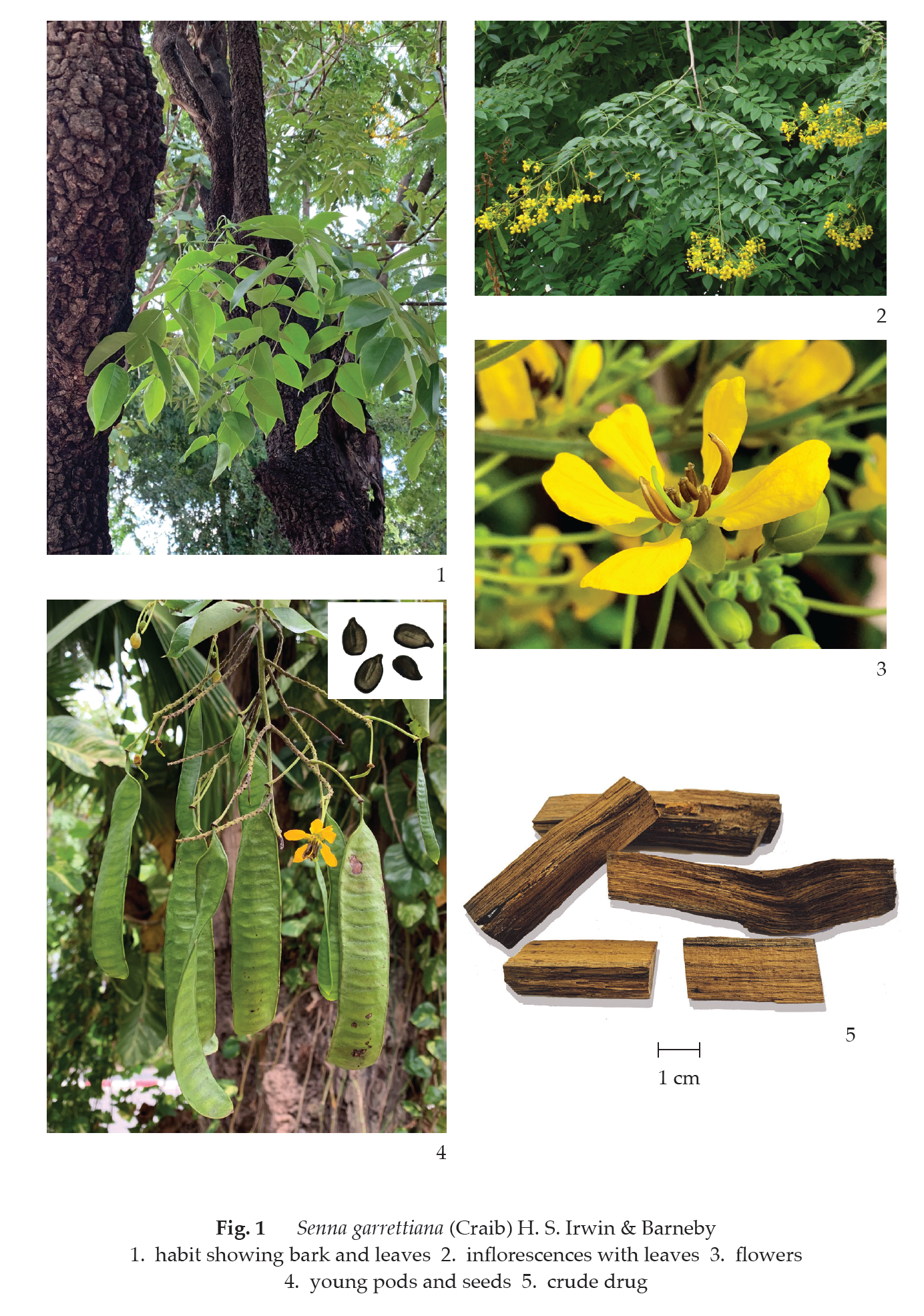
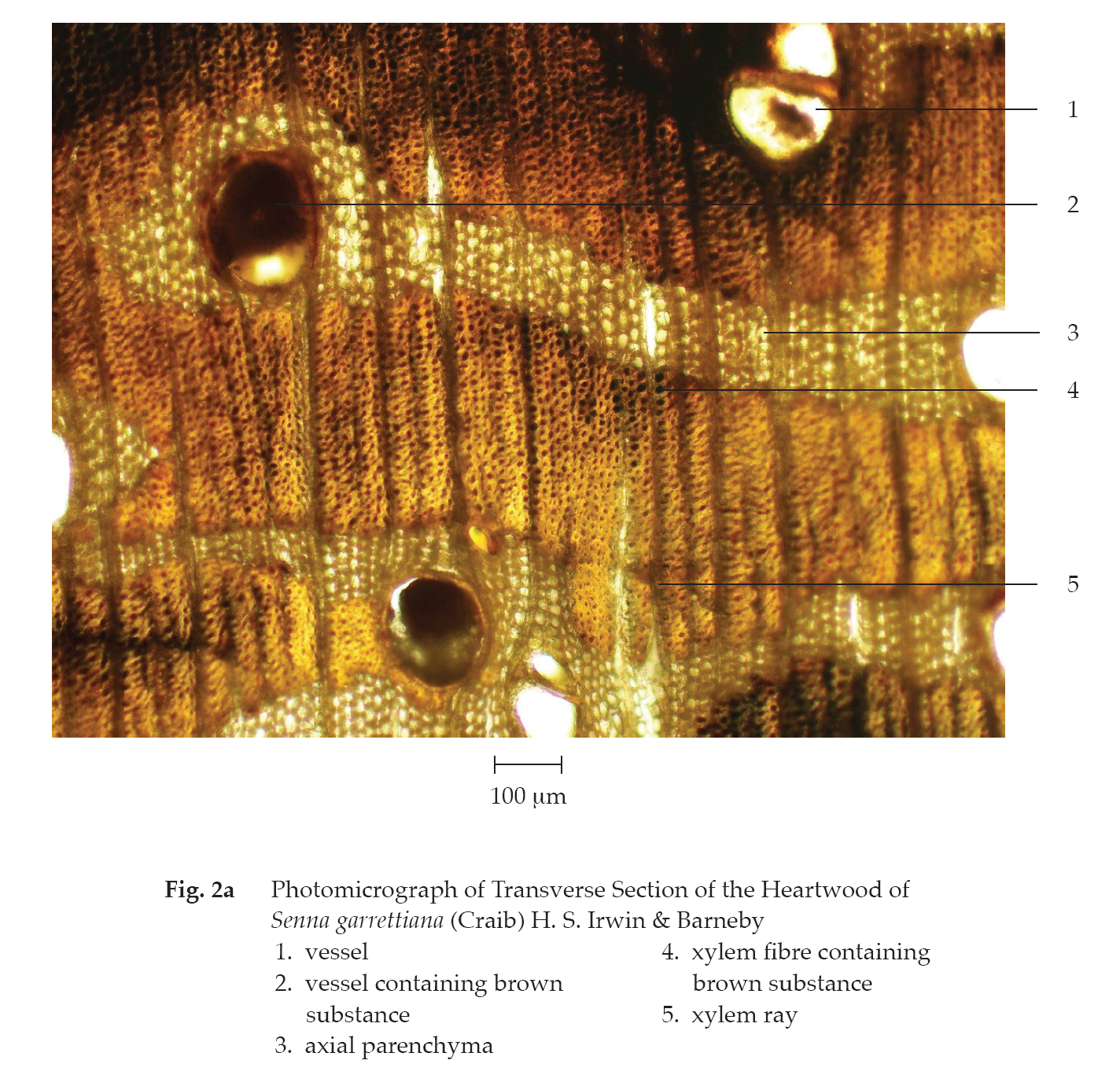
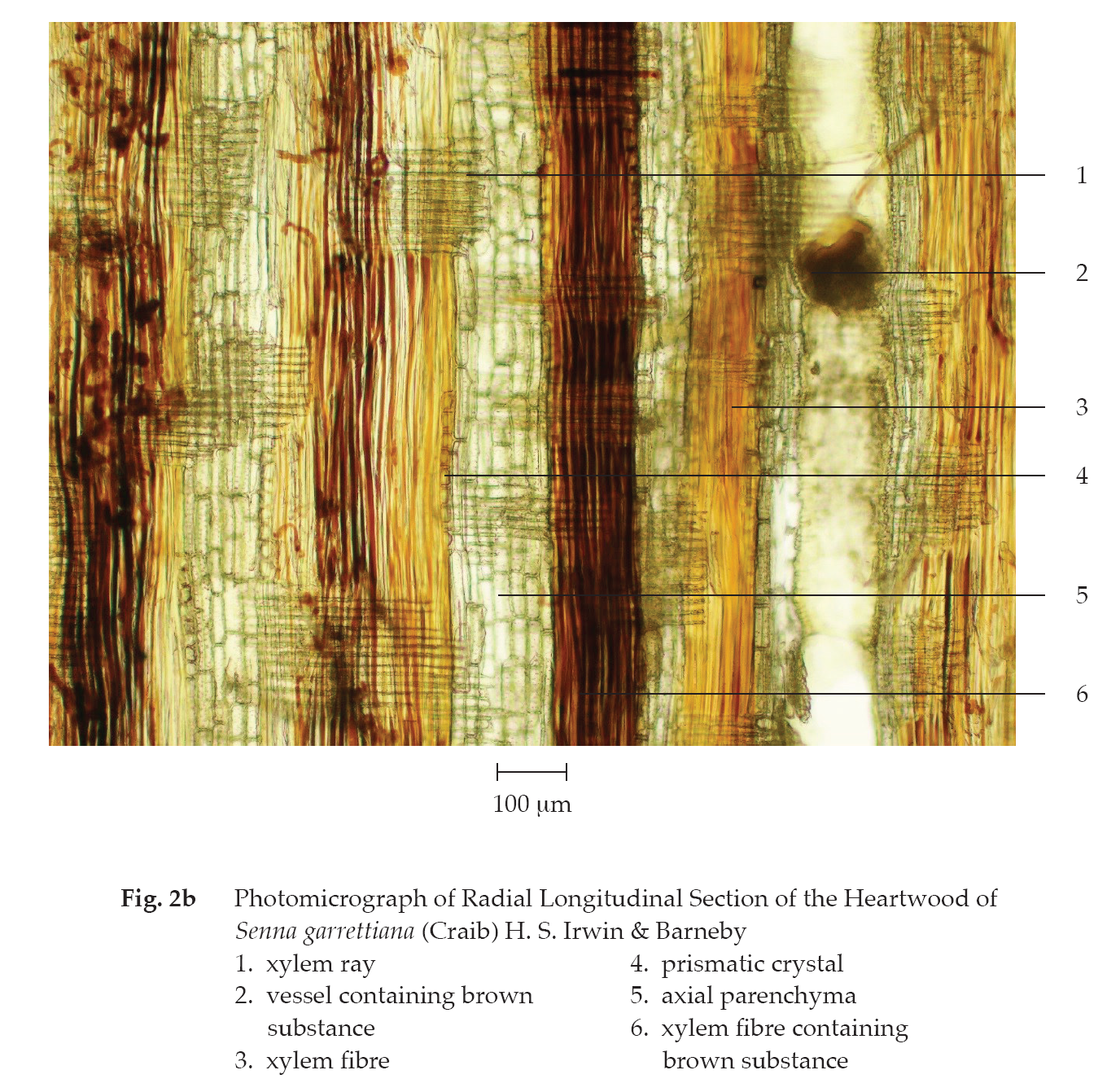
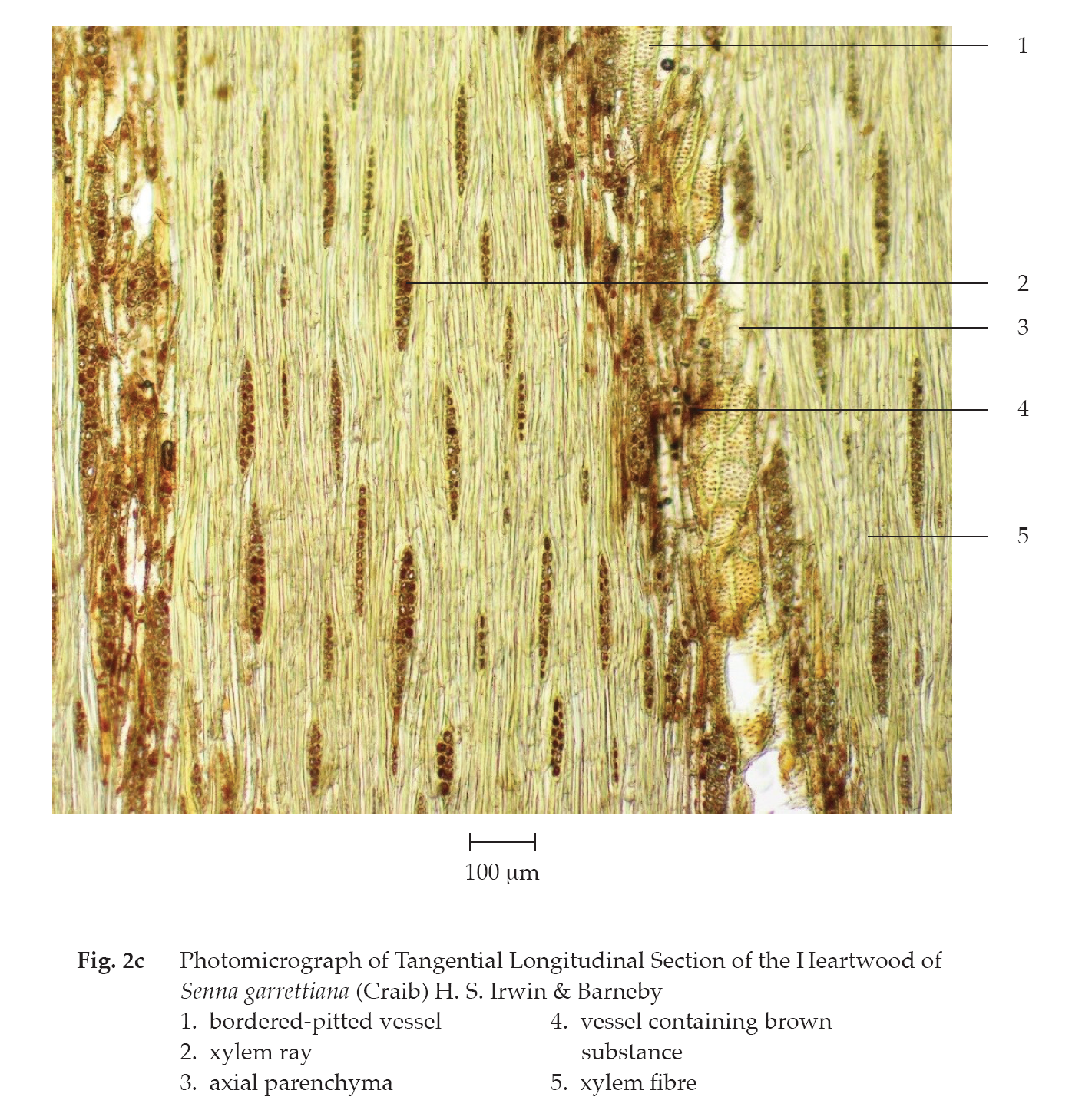

Packaging and storage Senna Garrettiana Heartwood shall be kept in well-closed containers, protected from light, and stored in a dry place.
Identification
A. To 1 g of the sample, in fine powder, add 10 mL of dichloromethane, warm on a water-bath for 5 minutes and filter. To 1 mL of the filtrate, add 1 mL of a 10 per cent w/v solution of potassium hydroxide: the aqueous layer becomes red.
B. Reflux 1 g of the sample, in fine powder, with 20 mL of ethanol for 15 minutes and filter. To 2 mL of the filtrate, add a few drops of iron(III) chloride TS: a dark blue colour is produced.
C. Carry out the test as described in the “Thin-Layer Chromatography” (Appendix 3.1), using silica gel F254 as the coating substance and a mixture of 60 volumes of toluene, 40 volumes of ethyl acetate and 5 volumes of formic acid as the mobile phase and allowing the solvent front to ascend 10 cm above the line of application. Apply separately to the plate as bands of 8 mm, 5 µL each of the following solutions. Prepare solution (A) by refluxing 1 g of the sample, in fine powder, with 10 mL of ethanol for 10 minutes and filtering. Evaporate the filtrate to dryness and dissolve the residue in 2 mL of ethanol. For solution (B), dissolve 1 mg of piceatannol in 1 mL of ethanol. After removal of the plate, allow it to dry in air and examine the plate under ultraviolet light (254 nm), marking the quenching bands. The chromatogram obtained from solution (A) shows a quenching band (hRf value 48 to 51) corresponding to the piceatannol band from solution (B); other quenching bands are also observed. Subsequently examine the plate under ultraviolet light (366 nm) through the cut-off filter, the band corresponding to piceatannol shows blue fluorescence. Several other fluorescent bands of different colours are also observed. Spray the plate with anisaldehyde TS and heat at 105° for 5 minutes; the band due to piceatannol is purple. Several other bands of different colours are observed. (Table 1); see also Fig. 3.
Table 1 hRf Values of Components in Ethanolic Extract of the Heartwood of Senna garrettiana (Craib) H. S. Irwin & Barneby
| Band | hRf Value | Detection | ||
| UV 254 | UV 366 | Anisaldehyde TS | ||
| 1 2 3 4 5 6 7* 8 9 10 11 12 |
10-12 12-15 16-18 28-30 38-40 41-42 48-51 54-55 58-60 78-81 84-87 90-95 |
- - - - weak quenching - quenching - weak quenching - - quenching |
light red light blue light blue blue blue light blue intense blue light blue light blue - - yellow |
pale brown - pale purple pale purple purple - dark purple - pale purple purple purple yellow |
*piceatannol
Loss on drying Not more than 8.0 per cent w/w after drying at 105° to constant weight (Appendix 4.15).
Foreign matter Not more than 2.0 per cent w/w (Appendix 7.2).
Total ash Not more than 9.0 per cent w/w (Appendix 7.7).
Ethanol-soluble extractive Not less than 6.0 per cent w/w (Appendix 7.12).
Water-soluble extractive Not less than 3.0 per cent w/w (Appendix 7.12).
